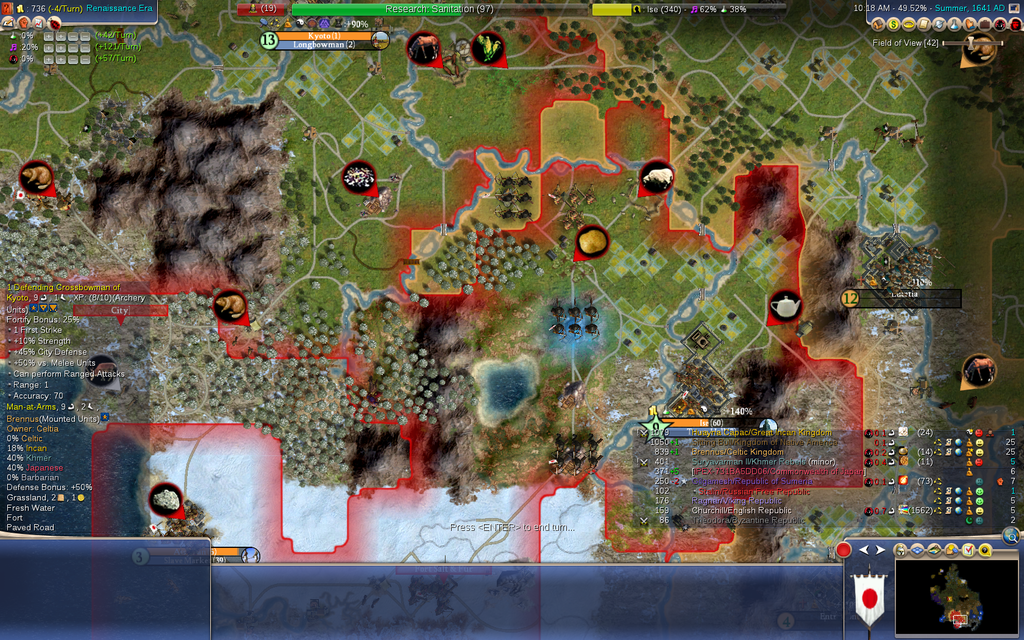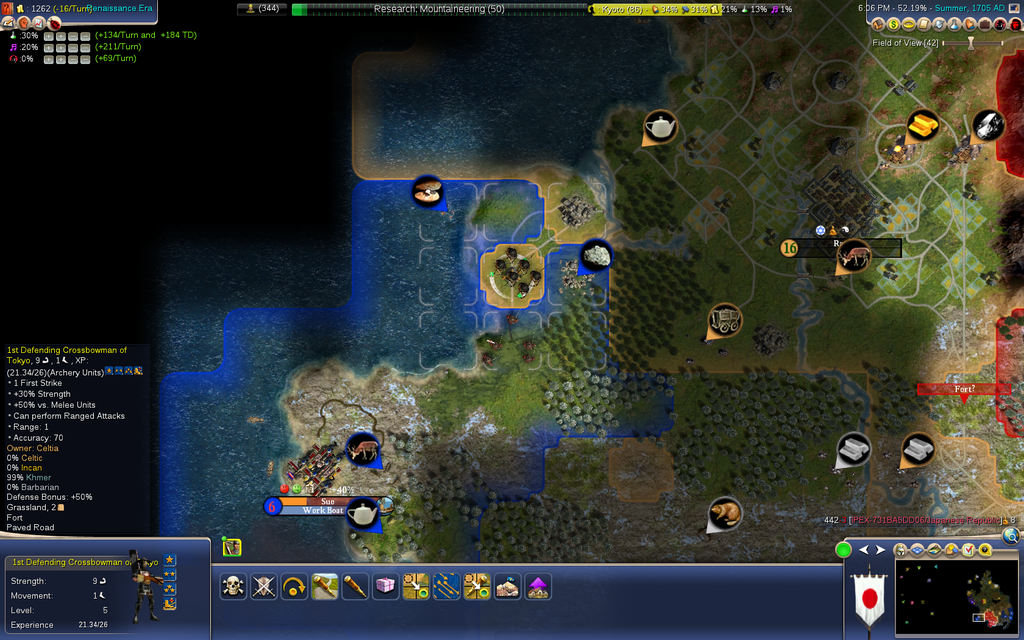fatgordy
Chicken in Pants
I'm having some trouble understanding some of the concepts with fixed borders. Sorry if there is already a post somewhere describing this, but I searched for about 20 minutes and couldn't readily find it. The Civlopedia helps a bit, but is unclear in a few areas.
A few questions I have:
1. If I have fixed borders enabled and I conquer an enemy city, how can I determine which tiles I will gain control of? Answer: When you conquer the city, all of the tiles that the CITY had the cultural influence over will be up for grabs for the duration of that turn. On the next turn, you will lose control of all tiles that you do not have the leading culture in AND do not have a military unit claiming territory there. If another civ has the most culture there and you have no military units there, they will gain control over it.
2. The civlopedia says if I have fixed borders, all I need to do is have some culture in that space to retain control of it. So I would assume that if that is the case, the only way those borders could change ownership is by another player "claiming" the tile. Even if I have no military presence in the tile. Is that a correct assumption? Answer: Wrong. If another civ has more culture and you do not keep a military unit there to maintain the claim, it will switch to the civ with the most culture.
3. If fixed borders is enabled via civics, can I still overtake rival tiles by overwhelming culture if they do not have fixed borders? Answer: Yes.
4. I see when I text hover over a tile next to a conquered city that it shows that the tile is in my control even though I do not have the most cultural influence. I also see that it has the name of my city after a comma after my civilization name. In some cases the city name is white, in some it's blue. What do these two colors indicate?
5. The civlopedia says that all 8 tiles around a city will ALWAYS (all caps in pedia) belong to that city. As you can see in the screenshot below, I founded a city (the one called Isabelle City - you can only see the letters "Isabe") but I do not control the three tiles to the north of it. Why? (the history of that city is that I razed an enemy city to the lower right of it and on the same turn built Isabelle. I had some units in the tiles that you see are claimed by me, but none in those three tiles. So they reverted to control of Walata in the next turn.) I'm assuming I lost control of those three because Isabelle didn't have any culture built up on that turn and I had no military presence. Answer: The 8 tiles rule is an artifact in the Civpedia from a previous version of AND. The Civpedia will be updated to remove it.
6. Also as you can see, when I conquered Pusan, I was able to retain control of the two tiles adjacent to Isvarapura. If I remove those military units, will I lose those tiles? I have some culture in those spaces so I think I should keep them. I'm not at war with the owner of Isvarapura. But if I do keep them, this conflicts with the Civpedia entry that says the owner of the city ALWAYS gets control of all 8 tiles around it. Answer: Removing my troops allowed those tiles to revert to Isvarapura because he had more culture in them than me. The only way I could maintain my claim on those tiles is to keep a military unit there until I have more culture in the tile.
7. I'm only at war with Korea right now (owner of Cuman). If I remove all of the military units around Isabelle City and Pusan, I would assume that all of those tiles will remain in my control because I have culture in all of them. Is that correct? Answer: Wrong. Removing my units allowed them to revert to the civ that had the most culture in them.
Thanks so much for any enlightenment you can provide!
On a side note, this is an amazingly awesome mod! I haven't played RoM for about 5 years and I'm really enjoying all of the changes that have been made recently! Great job to the mod team!!!

A few questions I have:
1. If I have fixed borders enabled and I conquer an enemy city, how can I determine which tiles I will gain control of? Answer: When you conquer the city, all of the tiles that the CITY had the cultural influence over will be up for grabs for the duration of that turn. On the next turn, you will lose control of all tiles that you do not have the leading culture in AND do not have a military unit claiming territory there. If another civ has the most culture there and you have no military units there, they will gain control over it.
2. The civlopedia says if I have fixed borders, all I need to do is have some culture in that space to retain control of it. So I would assume that if that is the case, the only way those borders could change ownership is by another player "claiming" the tile. Even if I have no military presence in the tile. Is that a correct assumption? Answer: Wrong. If another civ has more culture and you do not keep a military unit there to maintain the claim, it will switch to the civ with the most culture.
3. If fixed borders is enabled via civics, can I still overtake rival tiles by overwhelming culture if they do not have fixed borders? Answer: Yes.
4. I see when I text hover over a tile next to a conquered city that it shows that the tile is in my control even though I do not have the most cultural influence. I also see that it has the name of my city after a comma after my civilization name. In some cases the city name is white, in some it's blue. What do these two colors indicate?
5. The civlopedia says that all 8 tiles around a city will ALWAYS (all caps in pedia) belong to that city. As you can see in the screenshot below, I founded a city (the one called Isabelle City - you can only see the letters "Isabe") but I do not control the three tiles to the north of it. Why? (the history of that city is that I razed an enemy city to the lower right of it and on the same turn built Isabelle. I had some units in the tiles that you see are claimed by me, but none in those three tiles. So they reverted to control of Walata in the next turn.) I'm assuming I lost control of those three because Isabelle didn't have any culture built up on that turn and I had no military presence. Answer: The 8 tiles rule is an artifact in the Civpedia from a previous version of AND. The Civpedia will be updated to remove it.
6. Also as you can see, when I conquered Pusan, I was able to retain control of the two tiles adjacent to Isvarapura. If I remove those military units, will I lose those tiles? I have some culture in those spaces so I think I should keep them. I'm not at war with the owner of Isvarapura. But if I do keep them, this conflicts with the Civpedia entry that says the owner of the city ALWAYS gets control of all 8 tiles around it. Answer: Removing my troops allowed those tiles to revert to Isvarapura because he had more culture in them than me. The only way I could maintain my claim on those tiles is to keep a military unit there until I have more culture in the tile.
7. I'm only at war with Korea right now (owner of Cuman). If I remove all of the military units around Isabelle City and Pusan, I would assume that all of those tiles will remain in my control because I have culture in all of them. Is that correct? Answer: Wrong. Removing my units allowed them to revert to the civ that had the most culture in them.
Thanks so much for any enlightenment you can provide!
On a side note, this is an amazingly awesome mod! I haven't played RoM for about 5 years and I'm really enjoying all of the changes that have been made recently! Great job to the mod team!!!






 per turn hurts.
per turn hurts.
